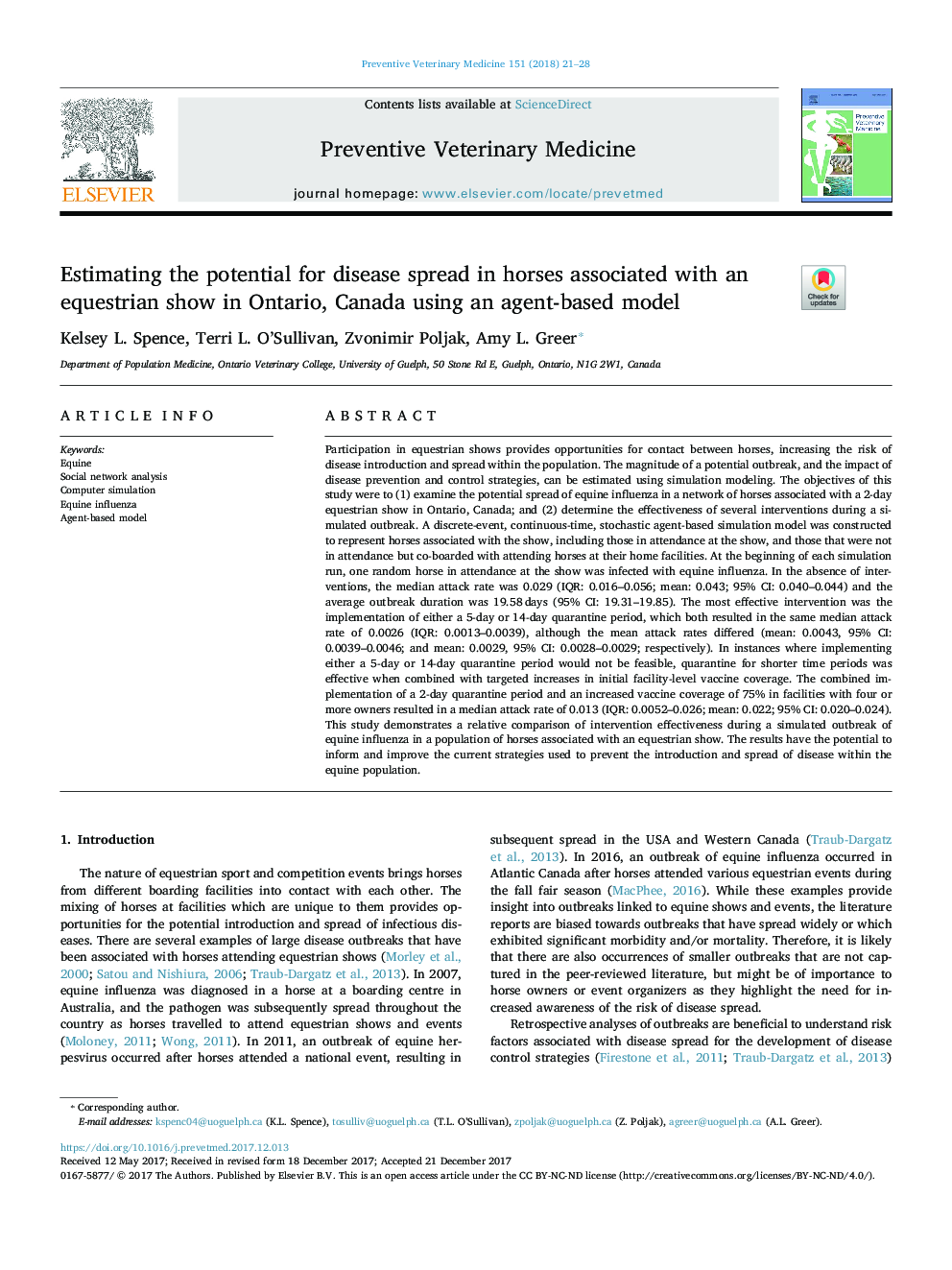| کد مقاله | کد نشریه | سال انتشار | مقاله انگلیسی | نسخه تمام متن |
|---|---|---|---|---|
| 8503514 | 1554139 | 2018 | 8 صفحه PDF | دانلود رایگان |
عنوان انگلیسی مقاله ISI
Estimating the potential for disease spread in horses associated with an equestrian show in Ontario, Canada using an agent-based model
ترجمه فارسی عنوان
برآورد پتانسیل بیماری گسترش اسب در ارتباط با یک نمایش اسب سواری در انتاریو، کانادا با استفاده از یک مدل مبتنی بر عامل
دانلود مقاله + سفارش ترجمه
دانلود مقاله ISI انگلیسی
رایگان برای ایرانیان
کلمات کلیدی
اسب ها، تجزیه و تحلیل شبکه شبکه، شبیه سازی رایانهای، آنفولانزای خوکی مدل مبتنی بر عامل،
موضوعات مرتبط
علوم زیستی و بیوفناوری
علوم کشاورزی و بیولوژیک
علوم دامی و جانورشناسی
چکیده انگلیسی
Participation in equestrian shows provides opportunities for contact between horses, increasing the risk of disease introduction and spread within the population. The magnitude of a potential outbreak, and the impact of disease prevention and control strategies, can be estimated using simulation modeling. The objectives of this study were to (1) examine the potential spread of equine influenza in a network of horses associated with a 2-day equestrian show in Ontario, Canada; and (2) determine the effectiveness of several interventions during a simulated outbreak. A discrete-event, continuous-time, stochastic agent-based simulation model was constructed to represent horses associated with the show, including those in attendance at the show, and those that were not in attendance but co-boarded with attending horses at their home facilities. At the beginning of each simulation run, one random horse in attendance at the show was infected with equine influenza. In the absence of interventions, the median attack rate was 0.029 (IQR: 0.016-0.056; mean: 0.043; 95% CI: 0.040-0.044) and the average outbreak duration was 19.58â¯days (95% CI: 19.31-19.85). The most effective intervention was the implementation of either a 5-day or 14-day quarantine period, which both resulted in the same median attack rate of 0.0026 (IQR: 0.0013-0.0039), although the mean attack rates differed (mean: 0.0043, 95% CI: 0.0039-0.0046; and mean: 0.0029, 95% CI: 0.0028-0.0029; respectively). In instances where implementing either a 5-day or 14-day quarantine period would not be feasible, quarantine for shorter time periods was effective when combined with targeted increases in initial facility-level vaccine coverage. The combined implementation of a 2-day quarantine period and an increased vaccine coverage of 75% in facilities with four or more owners resulted in a median attack rate of 0.013 (IQR: 0.0052-0.026; mean: 0.022; 95% CI: 0.020-0.024). This study demonstrates a relative comparison of intervention effectiveness during a simulated outbreak of equine influenza in a population of horses associated with an equestrian show. The results have the potential to inform and improve the current strategies used to prevent the introduction and spread of disease within the equine population.
ناشر
Database: Elsevier - ScienceDirect (ساینس دایرکت)
Journal: Preventive Veterinary Medicine - Volume 151, 1 March 2018, Pages 21-28
Journal: Preventive Veterinary Medicine - Volume 151, 1 March 2018, Pages 21-28
نویسندگان
Kelsey L. Spence, Terri L. O'Sullivan, Zvonimir Poljak, Amy L. Greer,
